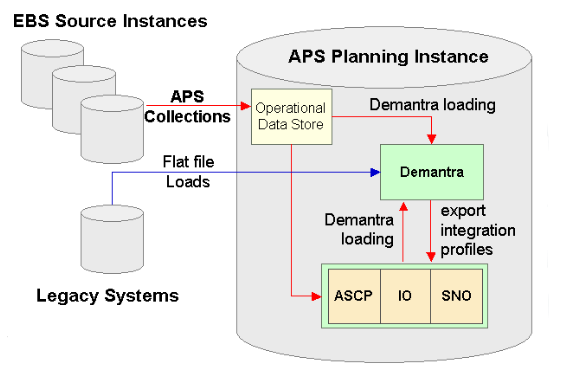
Oracle Demantra is the ultimate solution for demand management and supply chain planning. This comprehensive system offers a wide range of features, including demand forecasting, collaborative planning, trade promotion management, advanced analytics, and seamless integration with other supply chain tools. With these powerful capabilities, organizations can significantly enhance their supply chain efficiency, optimize inventory levels, and achieve unparalleled accuracy in demand forecasting. Don’t settle for a mediocre solution when you can have the best – choose Oracle Demantra and revolutionize your supply chain management today.
1. What is Oracle Demantra?
Ans:
Oracle Demantra is an advanced demand management and supply chain planning solution that helps organizations optimize their supply chain processes. Collaboration planning, trade promotion management, sales and operations planning, and demand forecasting are among the functions it offers.
2. Explain the key components of Oracle Demantra.
Ans:
The key components of Oracle Demantra include:
- The Demand Management Engine
- Series Engine
- Predictive Trade Planning
- Analytical Engine
- Collaborative Planning
- Lifecycle Planning
3. What are the main modules in Oracle Demantra?
Ans:
The primary Oracle Demantra components are Demand Management, Advanced Forecasting and Demand Modeling, Predictive Trade Planning, Collaborative Planning, and Sales and Operations Planning (S&OP).
4. How does Demantra support demand planning?
Ans:
- Demand modeling, cooperative planning, and sophisticated forecasting methods are how Demantra facilitates demand planning.
- It helps companies analyze historical data, project demand in the future, and make required adjustments to supply chain processes.
5. What is the role of the Demand Management Engine in Demantra?
Ans:
The Demand Management Engine in Demantra is responsible for processing and analyzing historical demand data. It utilizes various algorithms and statistical methods to generate accurate demand forecasts, aiding organizations in making informed decisions about inventory levels and production planning.
6. Explain the difference between Forecasting and Predictive Trade Planning in Demantra.
Ans:
| Aspect | Forecasting | Predictive Trade Planning | |
| Focus |
Future demand |
Trade promotion impact | |
| Purpose | Sales estimation | Promotion optimization | |
| Methodology | Statistical models | Analytical models | |
| Data Usage |
Historical sales, trends |
Promotion, pricing data |
7. How does Demantra handle seasonality in demand forecasting?
Ans:
- Demantra addresses seasonality in demand forecasting by recognizing patterns and trends related to seasonal fluctuations.
- It applies appropriate seasonal indices and adjustments to ensure accurate forecasting during different periods of the year.
8. How does Demantra integrate with other Oracle applications?
Ans:
Demantra integrates seamlessly with other Oracle applications, such as Oracle E-Business Suite and Oracle SCM Cloud. This integration enables a holistic view of the supply chain, connecting demand planning with other business processes for more effective decision-making.
9. What is the purpose of the Series Engine in Demantra?
Ans:
The Series Engine in Demantra is responsible for managing time-series data. It handles the creation, storage, and retrieval of time-series information, supporting the various forecasting and planning functionalities within the system.
10. What is the significance of Consensus Forecasting in Oracle Demantra?
Ans:
Consensus Forecasting in Demantra involves gathering input from various stakeholders in the organization, such as sales, marketing, and operations, to create a unified and collaborative demand forecast. It helps align different perspectives and ensures a more accurate representation of anticipated demand.
11. How does Demantra support collaborative demand planning?
Ans:
- Demantra supports collaborative demand planning by providing a platform for different stakeholders, including sales, marketing, and operations, to contribute their insights and data.
- The Collaborative Planning module fosters communication and consensus-building, leading to more accurate and comprehensive demand forecasts.
12. Explain the concept of “What-If” analysis in Oracle Demantra.
Ans:
“What-If” analysis in Oracle Demantra allows users to simulate and evaluate the impact of different scenarios on demand planning. It enables users to explore hypothetical situations, make adjustments to variables, and assess how changes would influence forecasts and overall supply chain outcomes.
13. How does Demantra handle promotions and events in demand planning?
Ans:
Demantra incorporates promotions and events into demand planning through its Predictive Trade Planning module. It considers factors such as promotional activities, pricing changes, and marketing events to provide a more accurate forecast that reflects the potential impact of these initiatives on product demand.
14. What is the role of workflow in Oracle Demantra?
Ans:
Workflow in Oracle Demantra streamlines and automates business processes related to demand planning. It ensures a structured and efficient flow of tasks, approvals, and notifications, enhancing collaboration among stakeholders and facilitating a more organized approach to demand management.
15. Explain the importance of Sales and Operations Planning in Demantra.
Ans:
- Sales and Operations Planning (S&OP) in Demantra is crucial for aligning sales, marketing, and operational strategies.
- It enables organizations to create a unified plan that balances supply and demand, optimizes inventory levels, and ensures efficient production and distribution processes.
16. What are the key features of Demantra’s Predictive Trade Planning?
Ans:
Demantra’s Predictive Trade Planning features advanced analytics to assess the impact of trade promotions on demand. It considers variables like pricing, promotions, and marketing strategies, helping organizations make informed decisions about trade promotion investments and their influence on product demand.
17. How does Demantra address the issue of demand volatility?
Ans:
- Demantra addresses demand volatility by employing advanced statistical models, machine learning algorithms, and predictive analytics.
- These tools enable the system to adapt to changing demand patterns and enhance the accuracy of forecasts in dynamic and volatile market conditions.
18. Explain the concept of “Lift and Shift” in Demantra.
Ans:
“Lift and Shift” in Demantra refers to the ability to replicate and apply forecasting models or strategies from one product or location to another. It streamlines the process of extending successful forecasting practices to similar items or regions, improving efficiency and consistency in demand planning.
19. What is the purpose of the Demand Classification Engine in Oracle Demantra?
Ans:
- The Demand Classification Engine in Demantra categorizes products based on their demand characteristics.
- It helps organizations tailor their forecasting and planning strategies for different product categories, considering factors like seasonality, variability, and lifecycle stage.
20. Explain Oracle Demantra Implementation process.
Ans:
The Oracle Demantra implementation process begins with project initiation, defining goals, and assembling a dedicated project team. Following this, The planning phase involves mapping out the integration of Demantra with existing systems and outlining a timeline for deployment. The subsequent steps include configuration, testing, user training, and ongoing support for a seamless transition to enhanced demand management and supply chain planning.

21. What types of reports and dashboards are available in Oracle Demantra?
Ans:
Oracle Demantra offers a range of reports and dashboards, including demand analysis reports, forecast accuracy dashboards, exception management reports, and collaborative planning dashboards. These tools provide users with comprehensive insights into demand planning metrics and facilitate informed decision-making.
22. How does Demantra handle data integration with external systems?
Ans:
- Demantra supports data integration with external systems through standard integration tools and interfaces.
- It can seamlessly connect with other Oracle applications, ERP systems, and external data sources, ensuring a synchronized flow of data for accurate demand planning.
23. What are the challenges of implementing Oracle Demantra?
Ans:
Challenges in implementing Oracle Demantra may include data quality issues, user adoption concerns, and integration complexities. These challenges can be mitigated through thorough data cleansing, user training programs, and engaging experienced implementation partners to address integration challenges effectively.
24. Explain the significance of statistical modeling in Demantra’s forecasting.
Ans:
- Statistical modeling in Demantra involves the application of advanced statistical methods to historical data for accurate demand forecasting.
- This ensures that the system can adapt to various demand patterns and make more precise predictions, enhancing the overall reliability of forecasts.
25. How does Demantra support demand-driven supply chain management?
Ans:
Demantra supports demand-driven supply chain management by aligning supply chain processes with actual customer demand. It ensures that production and inventory levels are optimized based on real-time demand signals, leading to improved responsiveness and reduced excess inventory.
26. What role does collaboration play in Demantra’s demand planning process?
Ans:
Collaboration is integral to Demantra’s demand planning process. The Collaborative Planning module allows stakeholders from different departments to contribute input, share insights, and work together to create a consensus demand forecast. This collaborative approach enhances the accuracy of forecasts.
27. How can you monitor the accuracy of demand forecasts in Demantra?
Ans:
- Demantra provides forecast accuracy metrics, such as Mean Absolute Deviation (MAD) and forecast bias, which users can monitor through accuracy dashboards.
- These metrics offer a quantitative assessment of the accuracy of demand forecasts, enabling continuous improvement.
28. What is the impact of demand variability on inventory planning in Demantra?
Ans:
Demand variability in Demantra influences inventory planning by requiring more robust safety stock strategies. The system takes into account the variability in demand patterns to ensure that sufficient inventory is maintained to meet customer demands even in fluctuating market conditions.
29. How does Demantra handle multi-dimensional analysis of demand data?
Ans:
- Demantra facilitates multi-dimensional analysis by allowing users to analyze demand data across various dimensions, such as product categories, regions, and time periods.
- This capability enables a comprehensive understanding of demand trends and patterns for effective planning.
30. What is the purpose of the Predictive Trade Planning Data Model in Oracle Demantra?
Ans:
The Predictive Trade Planning Data Model in Demantra is designed to capture and analyze data related to trade promotions. It serves as the foundation for predicting the impact of promotional activities on demand, allowing organizations to optimize their trade promotion strategies.
31. Explain the role of hierarchy management in Demantra.
Ans:
- Hierarchy management in Demantra involves organizing and structuring data hierarchies, such as product families or geographical regions.
- It plays a crucial role in facilitating multi-level analysis, enabling users to view and analyze demand data at various hierarchical levels for better insights and decision-making.
32. How can you customize and extend the functionality of Oracle Demantra?
Ans:
Oracle Demantra offers customization options through its extensibility framework. Users can leverage configuration settings, custom formulas, and scripting to tailor the system to specific business needs. Additionally, Oracle provides a Software Development Kit (SDK) for more advanced customization.
33. What are the different deployment options for Oracle Demantra?
Ans:
- Oracle Demantra can be deployed on-premises or in the cloud, providing flexibility for organizations to choose the deployment option that best suits their requirements.
- On-premises deployments offer control over infrastructure, while cloud deployments provide scalability and accessibility advantages.
34. How does Demantra support the concept of “Planning for Exceptions”?
Ans:
Demantra supports “Planning for Exceptions” by identifying and highlighting deviations from expected demand patterns. The system focuses on managing and planning for exceptional situations, such as sudden spikes or drops in demand, allowing organizations to proactively address anomalies.
35. Explain the concept of “Event Driven Forecasting” in Demantra.
Ans:
- “Event Driven Forecasting” in Demantra involves adjusting demand forecasts based on significant events, such as product launches or market promotions.
- The system considers these events as influencing factors in forecasting, providing a more accurate representation of expected demand.
36. What is the role of user roles and permissions in Demantra security?
Ans:
User roles and permissions in Demantra govern access to specific functionalities and data. They control user privileges, ensuring that individuals have the appropriate level of access based on their roles within the organization. This contributes to data security and confidentiality.
37. How does Demantra handle data cleansing and transformation?
Ans:
Demantra includes data cleansing and transformation tools to enhance data quality. These tools enable users to standardize, clean, and transform raw data, ensuring that the information used for forecasting and planning is accurate and reliable.
38. How does Demantra handle the integration of external market data?
Ans:
- Demantra facilitates the integration of external market data by allowing users to import and incorporate relevant external data sources.
- This integration ensures that the forecasting process considers external factors, providing a more comprehensive view of market conditions.
39. What is the purpose of the Demand History Engine in Oracle Demantra?
Ans:
The Demand History Engine in Demantra is responsible for storing and managing historical demand data. It plays a crucial role in analyzing past trends, patterns, and variations to inform the forecasting process, contributing to more accurate predictions of future demand.
40. Explain the significance of lifecycle planning in Oracle Demantra.
Ans:
Lifecycle planning in Oracle Demantra involves managing products through their entire lifecycle, from introduction to decline. It considers factors like product phase-out and end-of-life scenarios, ensuring that organizations can adapt their demand planning strategies based on the lifecycle stage of each product.
41. How does Demantra address the challenges of demand planning in the retail industry?
Ans:
- Demantra in the retail industry addresses challenges by considering factors like seasonality, promotional events, and dynamic consumer behavior.
- It employs advanced forecasting models and event-driven forecasting to accurately predict demand, helping retailers optimize inventory levels and enhance customer satisfaction.
42. What is the role of demand modeling in Demantra’s forecasting process?
Ans:
Demand modeling in Demantra involves creating mathematical representations of demand patterns based on historical data. These models use statistical algorithms and machine learning techniques to analyze trends and variations, contributing to more accurate and adaptable demand forecasts.
43. How can you handle outliers and anomalies in demand data in Demantra?
Ans:
- Demantra handles outliers and anomalies by incorporating exception management capabilities.
- It identifies and flags unusual demand patterns, enabling users to investigate and apply corrective measures.
- This ensures that abnormal data points do not significantly impact the accuracy of overall demand forecasts.
44. What is the role of attribute-based forecasting in Demantra?
Ans:
Attribute-based forecasting in Demantra involves considering product attributes, such as color, size, or style, to create more granular and accurate demand forecasts. This approach allows organizations to tailor their forecasting strategies based on specific attributes that influence customer preferences.
45. Explain the integration capabilities of Oracle Demantra with ERP systems.
Ans:
- Oracle Demantra integrates seamlessly with ERP systems, allowing for the exchange of data related to sales, inventory, and other relevant information.
- This integration ensures a synchronized flow of data between Demantra and ERP systems, creating a unified platform for comprehensive demand planning.
46. What are the key considerations for data governance in Oracle Demantra?
Ans:
Key considerations for data governance in Oracle Demantra include ensuring data accuracy, consistency, and security. Organizations need to establish data quality standards, implement data validation checks, and define roles and permissions to maintain a reliable and secure data environment.
47. How does Demantra handle lead time variability in supply chain planning?
Ans:
Demantra addresses lead time variability by incorporating lead time parameters into its supply chain planning models. It considers variations in the time it takes to procure or manufacture products, ensuring that lead time uncertainties are factored into demand planning and inventory management processes.
48. How does Demantra address the challenges of demand planning?
Ans:
- Demantra addresses demand planning challenges by providing a collaborative platform, advanced forecasting models, and scenario analysis capabilities.
- It allows users to work together, adapt to changing market conditions, and explore different planning scenarios to make informed decisions.
49. Explain the role of scenario planning in Oracle Demantra.
Ans:
Scenario planning in Oracle Demantra involves creating and analyzing multiple “what-if” scenarios to assess the potential impact on demand and supply chain processes. It helps organizations proactively plan for different situations, such as market fluctuations or unexpected events, ensuring better preparedness.
50. How can you optimize the performance of Oracle Demantra?
Ans:
- Optimizing the performance of Oracle Demantra involves regular system monitoring, tuning configurations, and ensuring efficient data management practices.
- Organizations can also leverage Oracle’s best practices and guidelines for system performance optimization to enhance the overall responsiveness of Demantra.
51. What is the role of Lifecycle Planning in Oracle Demantra?
Ans:
Lifecycle Planning in Oracle Demantra involves managing products through their entire lifecycle, from introduction to decline. It considers factors like product phase-out and end-of-life scenarios, ensuring that organizations can adapt their demand planning strategies based on the lifecycle stage of each product.
52. What is the approach to integrating external weather data in demand planning?
Ans:
- The approach to integrating external weather data in demand planning involves leveraging Demantra’s data integration capabilities to incorporate weather data sources.
- This integration allows organizations to account for weather patterns and their impact on consumer behavior, enhancing the accuracy of demand forecasts.
53. What is the approach to integrating external weather data in demand planning?
Ans:
“Promotional Lift” in Oracle Demantra refers to the positive impact that promotional activities, such as marketing campaigns or discounts, have on demand.
The system analyzes historical data to quantify the additional demand generated during promotions, enabling organizations to optimize their promotional strategies.
54. What are the key features of Predictive Trade Planning for consumer goods?
Ans:
Predictive Trade Planning for consumer goods in Oracle Demantra involves leveraging predictive analytics to optimize trade promotions. Key features include forecasting the impact of promotions on demand, analyzing historical promotion performance, and providing insights to enhance the effectiveness of future promotional activities.
55. What strategies can be used to incorporate market intelligence into the forecasting process?
Ans:
- Strategies to incorporate market intelligence into the forecasting process involve integrating external market data sources.
- Demantra allows organizations to import and analyze market intelligence data, providing a holistic view of market conditions and enabling more informed demand planning decisions.
56. What is the significance of statistical forecasting methods in Demand Management?
Ans:
In demand management, statistical forecasting techniques are crucial for projecting future demand based on trends in previous data. These techniques, which improve the precision of demand projections, offer a quantitative and data-driven approach to forecasting using time series analysis and regression analysis.
57. What is the role of advanced analytics and machine learning in Oracle Demantra?
Ans:
- Advanced analytics and machine learning in Oracle Demantra enhance forecasting accuracy by learning from historical data patterns.
- These technologies enable the system to adapt to changing demand trends and automatically improve forecasting models over time, leading to more precise predictions.
58. What are the techniques used to handle products with short lifecycles in demand planning?
Ans:
Techniques for handling products with short lifecycles in demand planning involve agile forecasting and rapid response strategies. Demantra allows organizations to adjust planning parameters dynamically for products with short lifecycles, ensuring that demand planning remains adaptable to rapidly changing market conditions.
59. What methods are employed to integrate demand signals from social media?
Ans:
- Demantra integrates demand signals from social media by allowing users to import and analyze data from social media platforms.
- Organizations can use sentiment analysis and other techniques to extract valuable insights from social media discussions, incorporating this information into the demand planning process.
60. What are the considerations for implementing Demantra in a cloud environment?
Ans:
Considerations for implementing Demantra in a cloud environment include assessing scalability, security, and integration capabilities. Organizations need to ensure that the cloud infrastructure meets their performance requirements while addressing data security and seamless integration with other cloud-based or on-premises systems.
61. What role does demand segmentation play in Oracle Demantra?
Ans:
- Demand segmentation in Oracle Demantra involves categorizing products or customers based on shared characteristics.
- It plays a crucial role in tailoring demand planning strategies to the specific needs and behaviors of different segments, enabling more accurate and targeted forecasting.
62. What is the importance of demand consensus meetings in collaborative planning processes?
Ans:
Demand consensus meetings in Oracle Demantra are essential for fostering collaboration among different stakeholders. These meetings bring together cross-functional teams to review and align on demand forecasts, ensuring a shared understanding and commitment to the forecasted demand.
63. What solutions are offered for demand planning challenges in spare parts?
Ans:
- Oracle Demantra addresses demand planning challenges in spare parts by offering specialized forecasting models for intermittent demand patterns.
- These models account for the sporadic nature of spare parts demand, ensuring accurate predictions and optimized inventory levels.
64. What is the significance of Demantra’s “On-the-Fly” forecast adjustments?
Ans:
Demantra’s “On-the-Fly” forecast adjustments are significant for making real-time modifications to forecasts based on changing conditions or unforeseen events.
Users can dynamically adjust forecasts during collaborative planning sessions, allowing for quick responses to market dynamics and improving overall forecast accuracy.
65. What is the significance of Demantra’s “On-the-Fly” forecast adjustments?
Ans:
Oracle Demantra integrates demand planning with financial planning processes by aligning forecasted demand with financial goals. This involves connecting demand forecasts to budgeting and financial reporting systems, ensuring that financial plans are based on accurate and synchronized demand projections.
66. What are the considerations for migrating from a legacy system to Oracle Demantra?
Ans:
Considerations for migrating from a legacy system to Oracle Demantra include data migration planning, ensuring compatibility with existing IT infrastructure, and providing adequate training for users. Organizations should also consider the specific functionalities and features offered by Demantra to meet their unique requirements.
67. What techniques can handle seasonality and cyclical patterns in demand data?
Ans:
- Techniques for handling seasonality and cyclical patterns in Oracle Demantra involve using seasonal adjustment methods, trend analysis, and advanced forecasting models.
- These techniques help the system recognize and adapt to recurring patterns in demand, improving the accuracy of seasonal demand forecasts.
68. What are the approaches used to integrate demand planning with financial planning processes?
Ans:
Oracle Demantra integrates demand planning with financial planning processes by aligning forecasted demand with financial goals. This involves connecting demand forecasts to budgeting and financial reporting systems, ensuring that financial plans are based on accurate and synchronized demand projections.
69. What is the role of Trade Promotion Optimization in demand planning?
Ans:
Trade Promotion Optimization in Oracle Demantra involves optimizing promotional activities to maximize their impact on demand. The system analyzes historical promotion performance, considers various factors, and provides insights to enhance the planning of future promotions, contributing to more effective demand planning.
70. What is the concept of “Concurrent Planning” in Oracle Demantra?
Ans:
“Concurrent Planning” in Oracle Demantra involves simultaneously considering multiple planning scenarios. Users can evaluate the impact of different factors or assumptions on demand forecasts and supply chain plans, enabling more informed decision-making in dynamic and complex environments.
71. What role do statistical forecasting engines play in Demantra?
Ans:
Statistical forecasting engines in Demantra play a critical role in predicting future demand based on historical data patterns. These engines use statistical algorithms and machine learning techniques to analyze trends, seasonality, and variations, contributing to more accurate and data-driven demand forecasts.
72. What methods are employed to handle demand planning for products with intermittent demand patterns?
Ans:
Demantra employs specialized forecasting models for products with intermittent demand patterns. These models account for the sporadic nature of demand, incorporating techniques like intermittent demand forecasting to ensure accurate predictions and optimized inventory levels.
73. What is the significance of Demantra’s “Event Modeling”?
Ans:
Demantra’s “Event Modeling” is significant for predicting the impact of events on demand. The system allows users to model and simulate the effects of various events, such as promotions or market changes, on demand forecasts. This capability enhances the accuracy of forecasts in dynamic business environments.
74. What are the strategies to optimize inventory levels using the Inventory Optimization module?
Ans:
Strategies to optimize inventory levels in Demantra’s Inventory Optimization module involve setting optimal reorder points, safety stock levels, and dynamically adjusting inventory policies based on demand variability. The module considers various factors to ensure that inventory levels align with demand forecasts and business objectives.
75. What role does predictive analytics play in Trade Promotion Management?
Ans:
Predictive analytics in Trade Promotion Management within Demantra involve forecasting the impact of promotional activities on demand. By analyzing historical promotion performance and considering various factors, predictive analytics help organizations optimize future promotions for maximum effectiveness and return on investment.
76. What solutions are offered for demand planning challenges?
Ans:
- Oracle Demantra addresses demand planning challenges by providing advanced forecasting models, collaborative planning capabilities, and real-time adjustments.
- Users of the system may optimize demand planning procedures by using predictive analytics, taking into account different planning situations, and dynamically adjusting projections.
77. What mechanisms support demand planning for products in Demantra?
Ans:
Demantra supports demand planning through collaborative planning processes, advanced forecasting models, and scenario analysis. The system provides a platform for cross-functional teams to collaborate on demand forecasts, while forecasting engines and analytics enhance the accuracy and adaptability of predictions.
78. What are the integration capabilities of Oracle Demantra?
Ans:
Oracle Demantra integrates seamlessly with various systems, including ERP, CRM, and supply chain planning systems. The integration capabilities facilitate the exchange of data related to sales, inventory, and other relevant information, ensuring a synchronized flow of data across the organization’s IT landscape.
79. What is the role of scenario analysis in Oracle Demantra?
Ans:
- Scenario analysis in Oracle Demantra involves evaluating the impact of different scenarios on demand forecasts and supply chain plans.
- Users can simulate various conditions, such as market changes, to assess the resilience and adaptability of their plans in dynamic business environments.
80. What considerations ensure data security and compliance in Oracle Demantra?
Ans:
Oracle Demantra employs robust access controls, encryption methods, and strict adherence to data governance standards to guarantee data security and compliance.
Organizations must develop and put into effect security policies in order to protect sensitive information and ensure adherence to relevant laws and regulations.
81. What are the key metrics and KPIs in Oracle Demantra?
Ans:
- Key metrics and Key Performance Indicators (KPIs) in Oracle Demantra include forecast accuracy, service level attainment, inventory turns, and demand variability.
- These metrics provide insights into the effectiveness of demand planning processes, inventory management, and the overall performance of the supply chain.
82. What is the role of attribute-based forecasting in Predictive Trade Planning?
Ans:
- Key metrics and Key Performance Indicators (KPIs) in Oracle Demantra include forecast accuracy, service level attainment, inventory turns, and demand variability.
- These metrics provide insights into the effectiveness of demand planning processes, inventory management, and the overall performance of the supply chain.
83. What is the concept of “Top-Down” and “Bottom-Up” forecasting?
Ans:
“Top-Down” forecasting involves deriving high-level demand forecasts and then disaggregating them to lower levels, while “Bottom-Up” forecasting starts with detailed forecasts at lower levels and aggregates them to higher levels. Demantra supports both approaches, allowing organizations to choose the most suitable method based on their planning needs.
84. What role do machine learning algorithms play in Demantra’s predictive analytics?
Ans:
- Machine learning algorithms in Demantra’s predictive analytics enhance the system’s ability to learn from historical data patterns and automatically improve forecasting models.
- These algorithms adapt to changing demand trends, contributing to more accurate and adaptive predictions over time.
85. What role does artificial intelligence (AI) play in Oracle Demantra?
Ans:
Artificial intelligence in Oracle Demantra enhances predictive analytics and forecasting by leveraging advanced algorithms to identify patterns, trends, and anomalies in large datasets. AI contributes to more accurate predictions, improved decision-making, and adaptability to changing market conditions.
86. What approaches handle integration capabilities with external ERP systems?
Ans:
- Demantra handles integration capabilities with external ERP systems through standardized interfaces, APIs, and data integration tools.
- This ensures seamless data exchange between Demantra and ERP systems, supporting synchronized information flow across the entire enterprise.
87. What are the best practices for ensuring a high level of user adoption?
Ans:
Best practices for ensuring high user adoption in Demantra include providing comprehensive training, creating user-friendly interfaces, involving users in the implementation process, and regularly communicating the benefits of the system. User engagement and ongoing support contribute to successful adoption.
88. What mechanisms support demand planning challenges in Demantra?
Ans:
- Demantra supports demand planning challenges through collaborative planning processes, advanced forecasting models, and scenario analysis.
- The system provides mechanisms to dynamically adjust forecasts, consider various planning scenarios, and leverage analytics to optimize demand planning in the face of challenges.
89. What is the role of exception management in Demantra’s demand planning process?
Ans:
Exception management in Demantra’s demand planning process involves identifying and addressing deviations from expected outcomes. It allows users to focus on anomalies, such as unexpected demand spikes or deviations from forecasts, ensuring timely interventions and adjustments to maintain planning accuracy.
90. What is the role of demand shaping in Trade Promotion Management?
Ans:
Demand shaping in Trade Promotion Management within Demantra involves strategically influencing demand through promotional activities. Organizations can shape demand by optimizing promotions based on historical performance and market conditions, ensuring that promotions align with overall demand planning goals.






